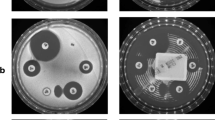Abstract
Disk diffusion susceptibility interpretive criteria for tebipenem against Staphylococcus spp. and Haemophilus influenzae were developed using the Clinical and Laboratory Standards Institute (CLSI) guidelines. Tebipenem was tested by disk diffusion and broth microdilution methods against 119 clinical isolates of Staphylococcus spp. and 102 clinical isolates of H. influenzae. The zone diameters of 5-, 10-, and 30-μg disks were compared with broth microdilution minimum inhibitory concentration (MIC) results by scattergram and regression analysis. When the MIC breakpoint of 1 μg/ml was applied to the scattergrams, the 10-μg disk showed good correlation between the zone diameters and the MIC values. The corresponding disk diffusion zone diameter breakpoints with the 10-μg disk for Staphylococcus spp. were ≧22 mm (MIC ≦1 μg/ml) for susceptible, 20–21 mm (MIC = 2 μg/ml) for intermediate, and ≦19 mm (MIC ≧4 μg/ml) for resistant. We also proposed the breakpoint zone diameter of H. influenzae: ≧22 mm (MIC ≦1 μg/ml) for susceptible. These criteria demonstrated that the categorical agreements between disk diffusion and broth microdilution methods for Staphylococcus spp. and H. influenzae were 95.0% and 99.0%, respectively. The discrepancy rates of these criteria were acceptable to the CLSI guidelines.



Similar content being viewed by others
References
Sunakawa K. Pharmacological properties and clinical performance of the novel oral carbapenem antimicrobial drug, “Tebipenem pivoxil” (Orapenem® fine granules 10% for pediatric use). Jpn J Chemother. 2009;57:279–94.
Clinical and Laboratory Standards Institute. Performance standards for antimicrobial susceptibility testing. Nineteenth informational supplement, M100-S19. Wayne, PA: CLSI; 2009.
Clinical and Laboratory Standards Institute. Performance standards for antimicrobial disk susceptibility tests. Approved standard, tenth edition, M02-A10. Wayne, PA: CLSI; 2009.
Clinical and Laboratory Standards Institute. Methods for dilution antimicrobial susceptibility tests for bacteria that grow aerobically. Approved standard, eighth edition, M07-A8. Wayne, PA: CLSI; 2009.
Clinical and Laboratory Standards Institute. Development of in vitro susceptibility testing criteria and quality control parameters. Approved guideline, third edition, M23-A3. Wayne, PA: CLSI; 2008.
National Committee for Clinical Laboratory Standards. Development of in vitro susceptibility testing criteria and quality control parameters. Approved guideline, second edition, M23-A2. Wayne, PA: CLSI; 2001.
Report from the Committee on Antimicrobial Susceptibility Testing. Japanese Society of Chemotherapy (1989). Chemotherapy (Tokyo). 1990;38:102–5.
Report from the Committee on Antimicrobial Susceptibility Testing. Japanese Society of Chemotherapy (1992). Chemotherapy (Tokyo). 1993;41:183–9.
Report of the Committee for Japanese Standards for Antimicrobial Susceptibility Testing for Bacteria. Clinical breakpoint for antimicrobial agents in pulmonary infections and sepsis. Chemotherapy (Tokyo). 1994;42:905–14.
Baba S, Kasahara H, Morita J, Aizawa K, Sunakawa K. Tissue and aural discharge distribution of tebipenem pivoxil. Jpn J Antibiot. 2009;62:127–35.
Totsuka K, Aizawa K, Morita J, Hori S, Sunakawa K. PK–PD analysis of tebipenem pivoxil in clinical trials for pediatric patients. Jpn J Chemother. 2009;57(S-1):186–91.
Ubukata K, Chiba N, Morozumi M, Hamano-Hasegawa K. Antibiotic susceptibility and resistance gene analysis of Streptococcus pneumoniae in clinical tebipenem-pivoxil studies in pediatric patients using PCR method. Jpn J Chemother. 2009;57(S-1):58–66.
Kishii K, Chiba N, Morozumi M, Hamano-Hasegawa K, Kimiko U. Antibiotic susceptibility and resistance gene analysis of Haemophilus influenzae in clinical tebipenem-pivoxil studies in pediatric patients using PCR method. Jpn J Chemother. 2009;57(S-1):67–75.
Yamada K, Sugano T, Baba N, Takayama Y, Mikuniya T, Maebashi K. In vitro antimicrobial activity of tebipenem. Jpn J Chemother. 2009;57(S-1):1–14.
Fuchs P, Barry A, Brown S. Selection of zone size interpretive criteria for disk diffusion susceptibility tests of three antibiotics against Streptococcus pneumoniae, using the new guidelines of the National Committee for Clinical Laboratory Standards. Antimicrob Agents Chemother. 2002;46:398–401.
Acknowledgments
We thank Meiji Seika Kaisha, Ltd. for their cooperation and for providing the clinical isolates.
Author information
Authors and Affiliations
Corresponding author
About this article
Cite this article
Fujisaki, M., Sadamoto, S., Ikedo, M. et al. Development of interpretive criteria for tebipenem disk diffusion susceptibility testing with Staphylococcus spp. and Haemophilus influenzae . J Infect Chemother 17, 17–23 (2011). https://doi.org/10.1007/s10156-010-0091-3
Received:
Accepted:
Published:
Issue Date:
DOI: https://doi.org/10.1007/s10156-010-0091-3




